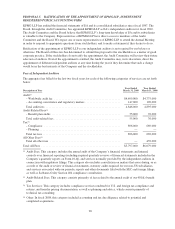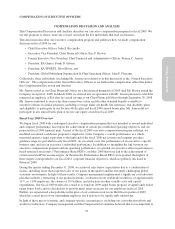Electronic Arts 2009 Annual Report Download - page 42
Download and view the complete annual report
Please find page 42 of the 2009 Electronic Arts annual report below. You can navigate through the pages in the report by either clicking on the pages listed below, or by using the keyword search tool below to find specific information within the annual report.address potential retention concerns with respect to employees critical to our restructuring efforts and our long-
term financial and operational success. In December 2008, we granted stock options to our executive officers,
including certain of the Named Executive Officers, and equity awards comprised of a mix of stock options and
RSUs to other key employees. In the fourth quarter of fiscal 2009, the Committee made the decision to extend the
performance period for the Performance-based RSUs granted to executive officers for an additional two years
through June 30, 2013, without changing the financial performance criteria of those awards.
Compensation Philosophy
We operate in an intensely competitive business environment, which is characterized by ongoing technological
advances, constantly changing and difficult-to-predict consumer tastes and preferences, and the continual
emergence of new competitors and technologies. Notwithstanding the global economic downturn, the market for
technical, creative, marketing and other personnel essential to the development, marketing, and sales of our
products remains extremely competitive. Similarly, the market for talented executives with the skills, experience,
integrity and dedication necessary to oversee a dynamic organization and the vision to anticipate and respond to
emerging market developments remains equally competitive if not more so in a challenging economic
environment.
Our success as a global leader in the interactive entertainment industry depends heavily on attracting, motivating,
and rewarding a highly-skilled and experienced management team. At the same time, our leading position within
the interactive entertainment industry makes us a prime target for our competitors (which range from very small
start-up companies with limited resources to very large, diversified corporations with greater financial and
marketing resources than ours) seeking to recruit executives and key creative talent.
Accordingly, it is imperative that our executive compensation program be competitive with the organizations
with which we compete for executive talent, so that we are able to attract, motivate, reward, and retain the
individuals that we believe are capable of leading the Company. At the same time, our program must support our
strategic business objectives, promote the short-term and long-term profitable growth of the Company, set
challenging performance goals and reflect current economic conditions. To achieve these objectives, our
compensation philosophy is predicated on two basic principles:
• A significant portion of each executive officer’s total cash compensation should be performance-based
and “at risk”, with this amount dependent from year to year on the Company’s financial and operational
performance, the operational performance of the executive’s specific business unit, as appropriate, and his
or her individual performance.
• To align each executive officer’s interests with the long-term interests of our stockholders, a significant
portion of his or her compensation should be equity-based.
Further, we believe that an executive officer’s compensation must be appropriate in light of his or her experience,
responsibilities, and performance. Our executive compensation program is designed to be consistent with this
philosophy and to maintain parity between the compensation of our executive officers.
Compensation-Setting Process
The Compensation Committee of the Board is responsible for establishing the Company’s compensation
philosophy and making the pay decisions for our executive officers. The Committee’s scope of authority is set
forth in a written charter and includes the oversight and administration of all compensation, equity, and employee
benefit plans and programs, including the annual bonus and equity compensation plans for executive officers.
The Committee has regularly-scheduled meetings on a quarterly basis and holds additional meetings as needed
during the year. The Committee also takes action by written consent, often after informal telephone discussions
and other communications among the Committee members and members of management. During fiscal 2009, the
Committee met 11 times, four of which were regularly-scheduled quarterly meetings and the remainder of which
were special sessions to consider a variety of items, including compensatory aspects of strategic transactions,
special compensation and equity retention programs, annual compensation reviews and increases, executive
promotions, executive relocations, the terms and conditions of the compensation arrangements for new,
departing, and continuing executives, and other administrative matters.
34
























